
Original Link: https://www.anandtech.com/show/5543/alienware-x51-the-xbox-with-teeth
Alienware X51: The Xbox With Teeth
by Dustin Sklavos on February 17, 2012 12:00 AM ESTIntroducing the Alienware X51
While Alienware isn't openly inviting comparisons to Microsoft's Xbox 360 with their brand new X51 gaming desktop, it's hard not to see the resemblance, at least in form factor. But where Microsoft's aging console continues trudging away with generations old hardware, Alienware has produced an authentic Windows 7 gaming PC in a shell roughly the same size. Not just that, but they're introducing it at one of the lowest prices we've ever seen for what's ordinarily a very premium brand. Was Alienware able to cram a fully-powered machine in this tiny chassis, or were too many sacrifices made?
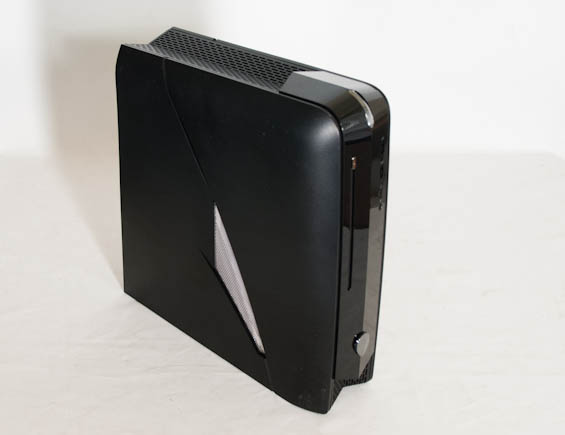
The X51 is basically the size of an Xbox 360, but the insides are pure PC: Alienware employs a Mini-ITX motherboard, desktop-level Sandy Bridge Intel processors, and a full-sized double-slot graphics card (rotated ninety degrees and connected via a riser card to the PCIe 2.1 x16 slot).
The component options available are listed below, and we've bolded the items from our review unit where applicable. Alienware currently has four models listed, with slightly varying specs. Our unit is the $949 model with an upgrade to 8GB RAM, though it's of course possible to upgrade other areas on your own.
| Alienware X51 Specifications | |
| Chassis | Custom Alienware X51 |
| Processor |
Intel i7-2600 (4x3.4GHz, Hyper-Threading, Turbo to 3.8GHz, 32nm, 8MB L3, 95W) Intel Core i5-2320 (4x3GHz, No Hyper-Threading, Turbo to 3.3GHz, 32nm, 6MB L3, 95W) Intel i3-2120 (2x3.3GHz, Hyper-Threading, No Turbo, 32nm, 3MB L3, 65W) |
| Motherboard | Custom H61 Chipset Board |
| Memory |
2x4GB Hynix DDR3-1333 2x2GB DDR3-1333 |
| Graphics |
NVIDIA GeForce GTX 555 1GB GDDR5 (OEM) (288 CUDA Cores, 736/1472/3828MHz core/shaders/RAM, 192-bit memory bus) NVIDIA GeForce GT 545 1GB GDDR5 (OEM) (144 CUDA Cores, 870/1740/3996MHz core/shaders/RAM, 128-bit memory bus) Intel HD 2000 IGP (6 EUs, 1100MHz core clock) |
| Hard Drive(s) | Seagate Barracuda 7200.12 1TB 7200RPM SATA 6Gbps HDD |
| Optical Drive(s) |
HL-DT-ST DVD+/-RW GA31N slot-loading drive Blu-ray/DVDRW Combo slot-loading drive |
| Power Supply |
330W Custom 240W Custom |
| Networking |
Dell Wireless 1502 802.11b/g/n (150Mbps 2.4GHz) Realtek PCIe Gigabit Ethernet |
| Audio |
Realtek ALC892 Speaker, mic/line-in, surround jacks, optical out and S/PDIF for 7.1 sound |
| Front Side |
Optical drive 2x USB 2.0 Headphone and mic jacks |
| Top | - |
| Back Side |
Optical and S/PDIF HDMI (IGP) 4x USB 2.0 Ethernet 2x USB 3.0 Speaker, mic/line-in, surround jacks 2x DVI-D (GeForce) 1x Mini-HDMI (GeForce) |
| Operating System | Windows 7 Home Premium 64-bit SP1 |
| Dimensions |
12.54"-13.5" (back-front) x 12.52" x 3.74" (318.5-343mm x 318mm x 95mm) |
| Weight | 12.1 lbs. (5.49kg) |
| Extras |
External PSU Integrated 802.11b/g/n User-configurable external lighting NVIDIA Optimus |
| Warranty | 1-year parts, labor, and support |
| Pricing |
Starts at $699 Review system configured at $999 |
Alienware keeps the configuration options for the X51 pretty lean, but they benefit tremendously from being a subdivision of Dell as opposed to a standalone boutique. The X51 enjoys a custom chassis design just like all of Alienware's hardware does, but they also have access to OEM only graphics hardware.
The entry level system offers Intel's Core i3-2120 dual-core processor, certainly plenty for gaming, and pairs it up with NVIDIA's GeForce GT 545. Our review unit steps each of these up to the next available part: the Intel Core i5-2320 and GeForce GTX 555. Unfortunately the X51 maxes out at the GTX 555 while the processor can be upgraded to a Core i7-2600 for users who want an extra 400MHz plus Hyper-Threading on the CPU.
The GT 545 and GTX 555 are odd birds in and of themselves, but the graphics card in the X51 is user upgradeable. So why these parts? The GT 545 is a touch above entry-level; it's a GDDR5-equipped part (OEM only as opposed to the DDR3-equipped retail parts) and sports a cut-down GF116 GPU, with 144 CUDA cores and a 128-bit memory bus hooked up to 1GB of GDDR5. The chip is clocked at 870MHz (putting the shaders at 1.7GHz) and the memory is clocked at an effective 4GHz.
More compelling is the GeForce GTX 555 that our review unit is equipped with. Due to limitations on the X51's external power supply, the X51 can't handle graphics cards rated for more than 150 watts. Thankfully the GTX 555 maximizes that power envelope; it employs a trimmed-down GF114 GPU with 288 CUDA cores enabled along with a 192-bit memory bus and 1GB of GDDR5. That's an asymmetrical memory configuration just like the desktop GTX 550 Ti has but on different silicon. The GPU itself is clocked at 736MHz (for 1472MHz on the shaders) and the memory runs at an effective 3.8GHz. Note also that models that ship with the upgraded GTX 555 GPU get the larger 330W external power brick, so if you're thinking about upgrading to a different GPU in the future you will most definitely want to go with the higher spec system.
The icing on the graphics cake is that the X51 is the first instance of desktop Optimus we've seen. That's right: you can actually plug your monitor into the IGP's HDMI port and the tower will power down the GPU when it's not in use. This implementation functions just like the notebook version does, and it's a welcome addition.
Where I think Alienware does lose a point is in the storage configuration. Understanding internal real estate is at a premium, the single 3.5" drive bay still hurts a little at a time when the ideal system configuration is an SSD for a system drive and a mechanical disk for storage. The 1TB Seagate Barracuda 7200.12 included isn't bad, but it will hurt the X51 in PCMark testing and detracts a little from the overall user experience. Given the sloped shape of the chassis, however, we would have preferred a modified design with space for a 2.5" SSD/HDD at the back. That said, the X51's motherboard has enough SATA ports for you to remove the 3.5" drive and replace it with a pair of 2.5" drives, so the enterprising end user can opt to install an SSD and notebook hard drive.
Finally, the X51 supports USB 3.0 on the back, has a slot-loading optical drive that can be upgraded to a Blu-ray reader, and has wireless networking included on a user-replaceable mini-PCIe card that's mounted to the motherboard.
The final price of $1000 for our review unit gets you a very interesting piece of hardware, though obviously there's a price premium for going with the custom Mini-ITX chassis, PSU, etc. You could put together a similar system in terms of performance with a Micro-ATX case/motherboard for under $800 quite easily, but if you want to go the Mini-ITX route things become a bit more difficult--both in terms of finding hardware that will all fit and work together well, plus the assembly process in ITX chassis generally requires more time and effort than mATX. Overall then, the price and specs are very reasonable, so let's see what this black beauty can do on the race track.
System Performance
One thing I'd like the readership to keep in mind when looking at these charts is that the Alienware X51 review unit we have on hand is just $999, and the $949 version with only 6GB of RAM will probably perform comparably. That means the desktops it's competing with here are almost all between two to three times more expensive; the only one in the same price bracket is the WarFactory Sentinel, but that system was reviewed nearly a year ago.
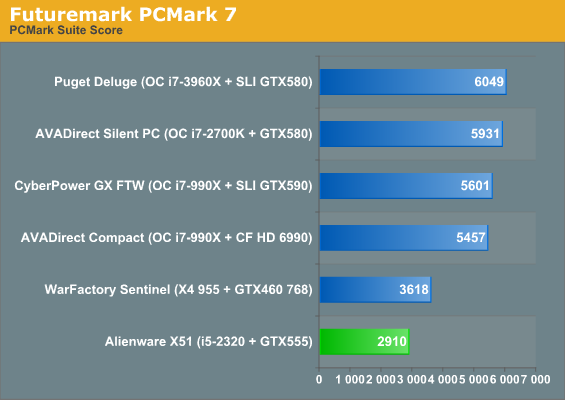
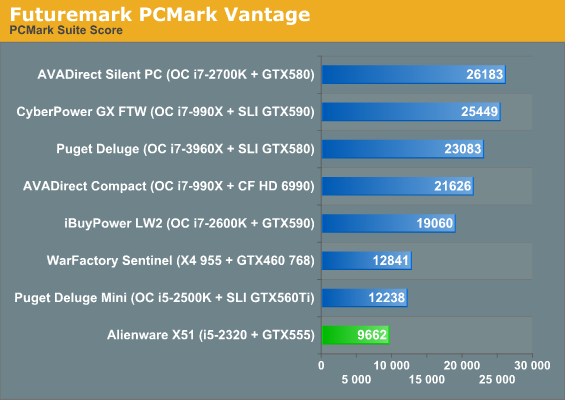
PCMark certainly takes the X51 to task, but keep in mind that every other system tested here is sporting an SSD while the X51 is making do with a mechanical hard disk. PCMark skews very heavily towards SSD-enabled systems; that's why the AMD Phenom II X4 955 in WarFactory's tower is able to post a lead on the Alienware's substantially faster i5-2320. Nnot that we're disputing how big of an impact that can have in the real world--in many use cases, a moderate Phenom II system with an SSD will feel snappier than a faster Core i5/i7 with a hard drive.
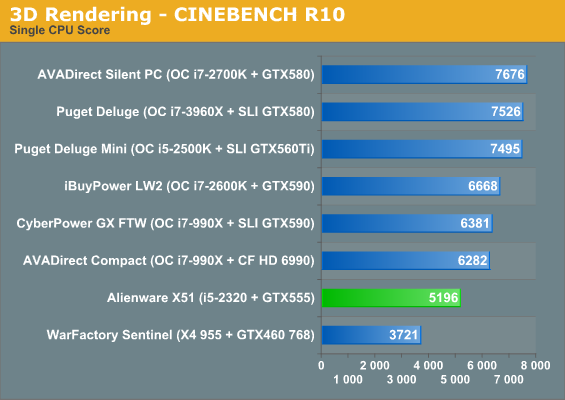
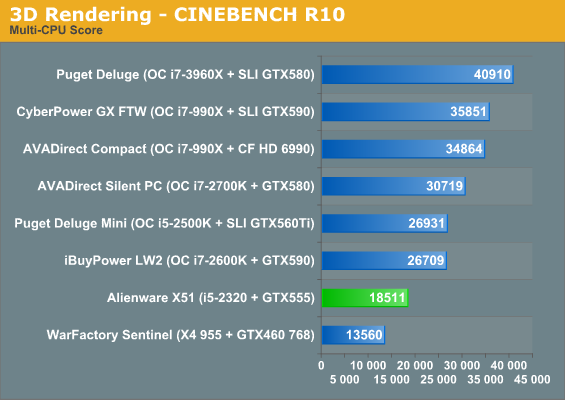
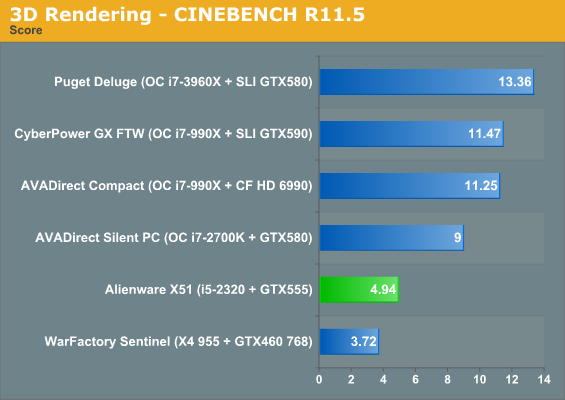
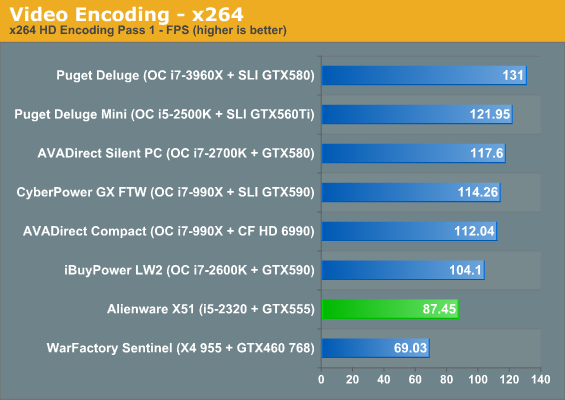
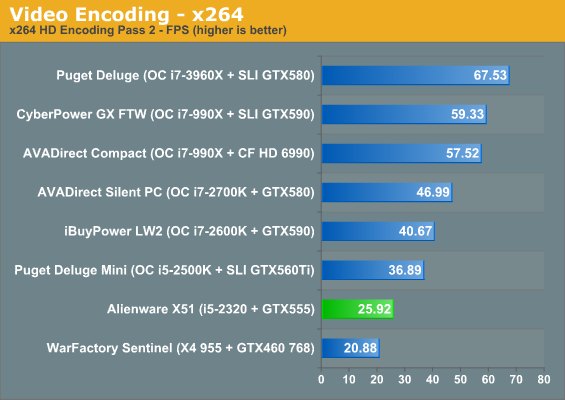
Once we get to the more CPU-centric application tests the X51 fares a bit better, and again here it's competing with desktops that are almost all running 4GHz or better overclocked processors. CPU performance is still actually quite good, and the i5 definitely offers a better value now than the Phenom II in WarFactory's machine did.
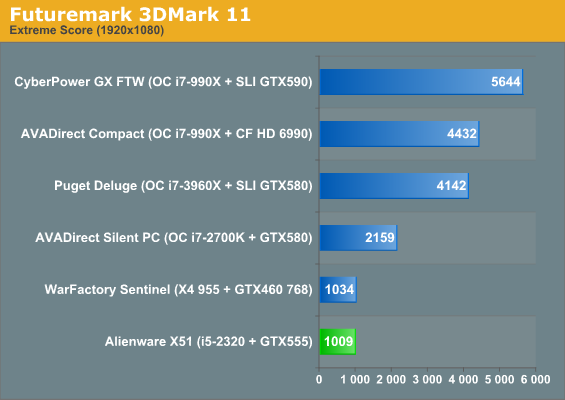
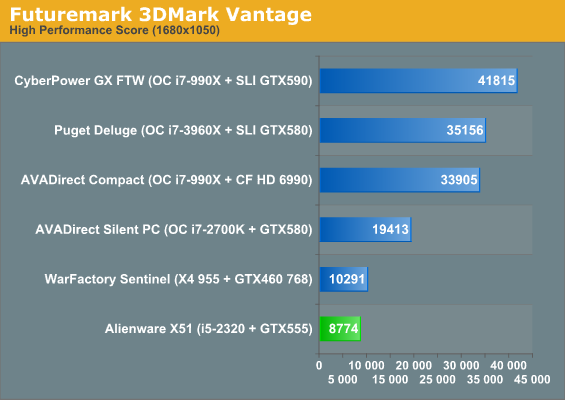
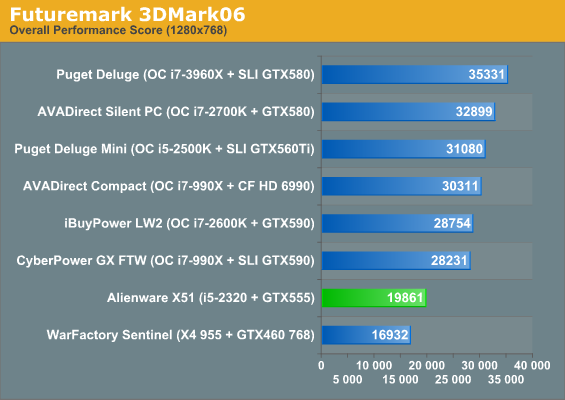
On the other hand, the GeForce GTX 460 in the WarFactory machine is definitely a faster video card than the X51's GTX 555, but it's not the most massive lead in the world, and in 3DMark06 the Sentinel winds up being CPU limited. The GTX 555 may very well have its work cut out for it, though; Alienware promises the X51 is able to deliver a compelling gaming experience, but is it going to be able to hack 1080p gaming?
Gaming Performance
This is the real measure by which the Alienware X51 will be judged. Alienware seems to have tried to cram as much GPU power as possible into the X51, but I do have to wonder if AMD's (admittedly now outdated) Radeon HD 6850 might not have been a better choice. The HD 6850 certainly fits well within the X51's power envelope, but then again, the end user would lose the benefit of NVIDIA's Optimus power-saving technology. That said, the benefits of that technology on the desktop are a little bit foggier than they are in a notebook. It's really a tough call either way, depending upon your usage model.
Where our charts unfortunately are going to come up a bit short are in comparisons. Because we recently revamped our gaming benchmark suite, there's only one system we can compare the X51 to: the recently-reviewed AVADirect Silent Gaming PC. That isn't necessarily a fair fight, either, with AVADirect's system costing 2.5 times as much and enjoying a GeForce GTX 580. Still, one data point is better than none, but try to maintain perspective: Alienware is targeting 1080p gaming, but our desktop gaming suite is brutal, and the GTX 580 is roughly twice as powerful in hardware.
In case you missed it, note that again we're using the same selection of games as our laptop reviews, only we're running 1080p using our Mainstream and Enthusiast settings. Since we don't have all of the previously reviewed systems available, we've included the only 1080p Mainstream results we have right now in one chart.
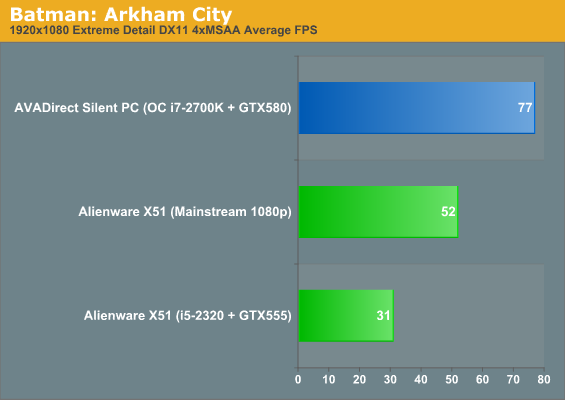
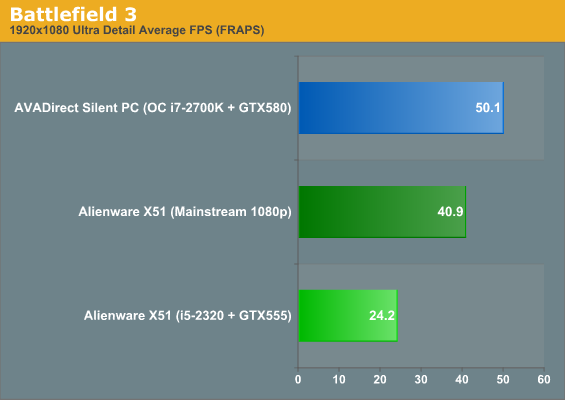
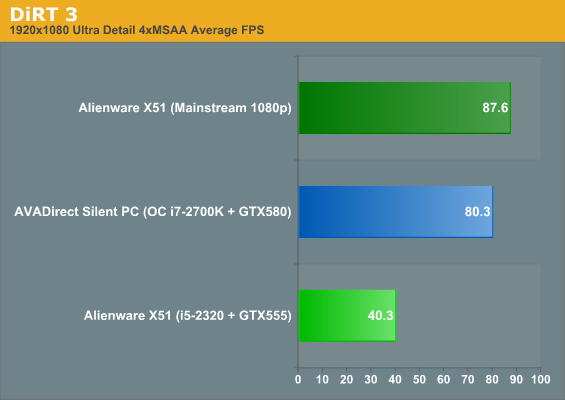
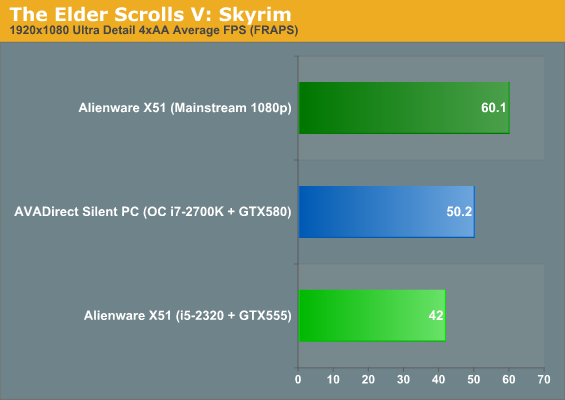
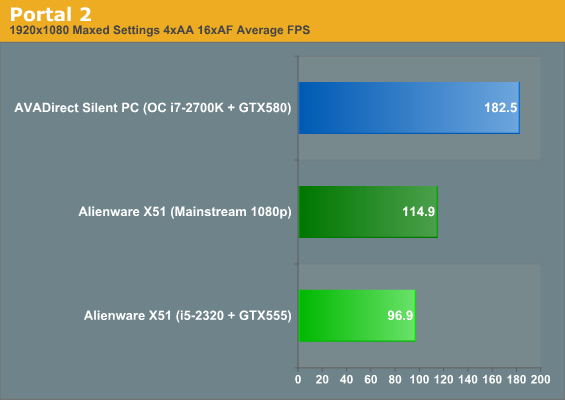
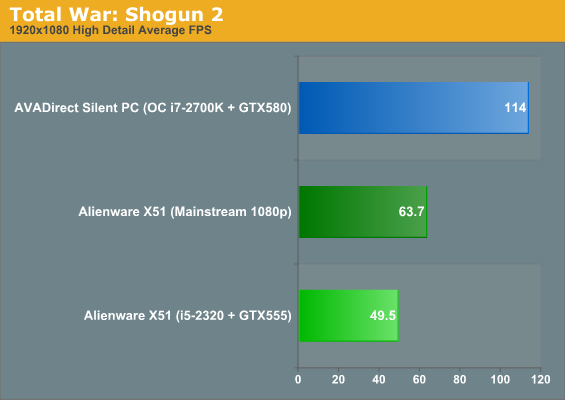
What's impressive is that the X51 actually posts fairly strong numbers in our gaming testing. Anti-aliasing is going to be out of the question in many cases (e.g. the Enthusiast results), but Alienware seems to have largely been successful in achieving what they set out to achieve: the GTX 555 version can definitely handle our Mainstream 1080p gaming suite.
Where things do get a little foggier is the Optimus support. Total War: Shogun 2 flat out refused to run while the IGP was enabled; we had to connect the monitor directly to the video card instead of the IGP's HDMI port to get the game to work. This bug was reported to NVIDIA and Alienware, and since the X51 uses standard NVIDIA drivers this should hopefully be fixed in the future.
We also discovered a minor hiccup in our testing suite involving the monitor we use for testing desktops: the Acer HN274H has a bug where it can incorrectly report the resolution it supports, regardless of HDMI, DVI, or VGA connection, and this bug reared its ugly head in Civilization V testing on both the X51 and on the AVADirect system. Unfortunately, despite working with NVIDIA on the issue, we didn't figure out it was the monitor until the X51 exhibited the same issue (refusing to benchmark at 1080p and knocking the resolution down to 1680x1050), so we don't have results for AVADirect's tower. That said, the X51 was able to produce over 30fps in Civilization V (34.7 at Enthusiast and 43.6 at Mainstream 1080p to be exact.)
Build, Heat, and Power Consumption
Where I think Alienware has benefitted the most from their relationship with Dell is actually in these areas, and the X51 makes a strong case for buying a prebuilt instead of going the DIY route for Mini-ITX. The X51 uses a custom chassis and everything inside is sandwiched fairly neatly together. Although it was a little difficult to take apart, the tower is still basically laid out in a logical way, with the graphics card mounted to a riser card and essentially being an entire removable piece. The hard drive bay is then located beneath it, while the motherboard sits under the optical drive bay. The power supply is an external power brick connected to the back of the system.
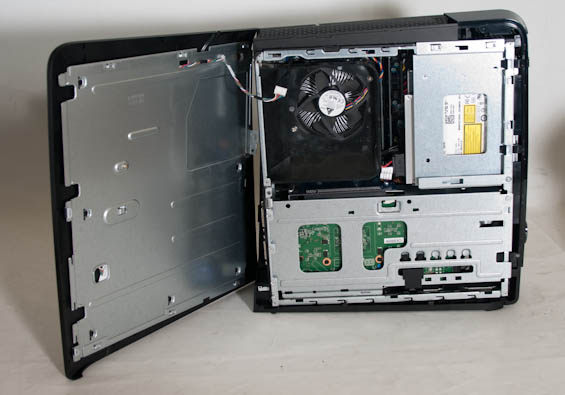
What I'm not as much of a fan of is the glossy finish accent on the front of the case, as well as the USB 3.0 connectivity being confined to the rear ports. Our review unit also unfortunately came to us with a crack next to the power button, and the button itself would stick a little bit. This system has seen more than its fair share of shipment and manhandling to be sure, but it's something to keep in mind: the X51 feels pretty solid, but it's far from bulletproof.
Finally, Alienware includes their traditional configurable lighting scheme: the rotateable alien logo on the front of the case can have its illumination color configured across the spectrum, just like the two dim lights on the sides. The lighting is cute and not at all obtrusive, but if you're not a fan, their Control Center application will allow you to disable it entirely.
With such a compact design one would expect the X51 to be both loud and hot, but surprisingly this isn't the case. Quite the opposite actually; the X51 is cooler and quieter at both idle and load than the first-generation Xbox 360 was.
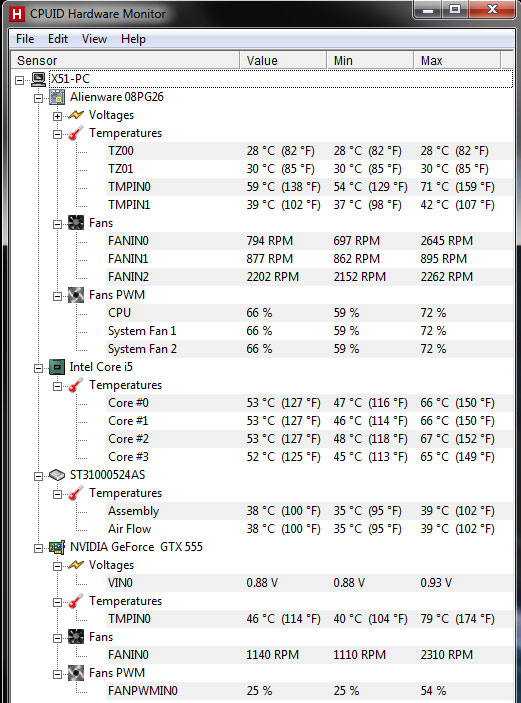
The CPU thermals are nothing short of excellent, with peak temperatures well under 70C, while the GPU's peak temperature of 79C isn't much to worry about. While there's some variation in fan speeds and the system is actually quite loud at POST (where the fans initially run at max RPM), in practice the X51 runs below 40dB at both load and idle, and you have to really listen to hear the difference.
For such a compact system, Alienware has done an excellent job of keeping heat and noise in check while producing a reasonably powerful computing experience. So what about power consumption?
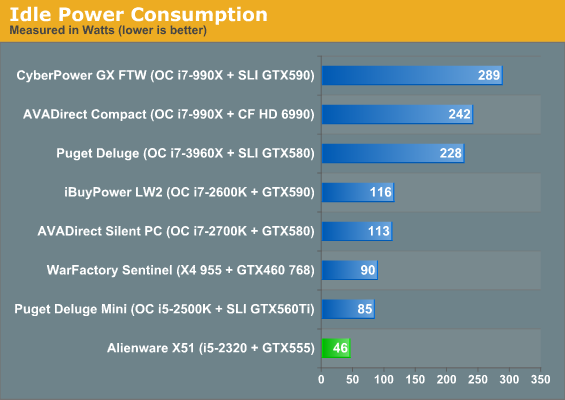
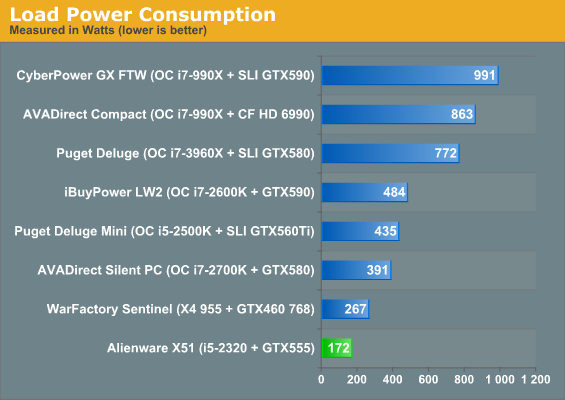
Alienware is able to leverage NVIDIA's Optimus technology to produce idle power consumption that's nearly half of the next system up on the chart. Under heavy load, the X51 still barely draws any juice from the wall and clearly has some wiggle room on the power supply. 172 watts for a reasonably comfortable 1080p gaming experience isn't too shabby at all.
Conclusion: Gaming Made Fun Size
It's hard not to walk away from the Alienware X51 feeling at least a little impressed. While I have to wonder a why Dell and Alienware didn't opt to wait for Kepler and Ivy Bridge, at the same time we can probably be certain that a refresh with those technologies will be en route once they launch. In the meantime, Alienware has produced a system that wouldn't look at all out of place next to other gaming consoles or other home entertainment hardware.
What's inside counts just as much, though, if not more, and here Alienware again delivers. The internal design of the X51 is smart, consisting of standardized hardware that's assembled in such a way as to allow the end user a measure of freedom and configurability while also doing an excellent job of keeping the internals organized. More importantly, the system runs coolly and quietly. While the 150-watt limitation on the graphics card does hurt at least a little bit, 150-watt cards have been perfectly adequate for gaming at 1080p for a while now, and we're already on the eve of another refresh that should continue to push impressive performance into tighter and tighter thermal envelopes.
If we had to find fault with the X51, the glossy plastic front finish is definitely going to be prone to smudges (not to mention just looking cheap in general), and there's really no reason for the front USB ports not to be 3.0 capable. That front finish also seems to be at least a little bit on the fragile side. Understanding that SSDs are still on the expensive side, I also wish that Alienware had made an allowance for including a 2.5" drive inside the system; there should be at least a little space beneath the optical drive for one, and SSDs don't exactly throw off a lot of heat. Having to live with a single 3.5" hard drive really hampers performance and thus the user experience somewhat. An SSD doesn't need to be mandatory and it would drive the price up, but the option should exist.
 Ultimately, though, the X51 is a heck of a product. It's essentially Alienware's "budget" PC, but it's also very capable, and the small form factor and low power consumption make it compelling in ways that transcend Alienware's target market. A visit to NewEgg reveals virtually nothing in the way of competition on price, either; only pre-built machines from CyberpowerPC compete, and those don't have the benefit of being small form factor, let alone everything else the X51 brings to the table. Were it not for the quibbles with the finish and connectivity, the X51 would be in the running for a silver or even gold Editor's Choice award. As it stands, though, it's certainly worth of a Bronze Editor's Choice Award and a place on the shortlist of anyone looking for a relatively inexpensive but powerful gaming desktop.
Ultimately, though, the X51 is a heck of a product. It's essentially Alienware's "budget" PC, but it's also very capable, and the small form factor and low power consumption make it compelling in ways that transcend Alienware's target market. A visit to NewEgg reveals virtually nothing in the way of competition on price, either; only pre-built machines from CyberpowerPC compete, and those don't have the benefit of being small form factor, let alone everything else the X51 brings to the table. Were it not for the quibbles with the finish and connectivity, the X51 would be in the running for a silver or even gold Editor's Choice award. As it stands, though, it's certainly worth of a Bronze Editor's Choice Award and a place on the shortlist of anyone looking for a relatively inexpensive but powerful gaming desktop.












